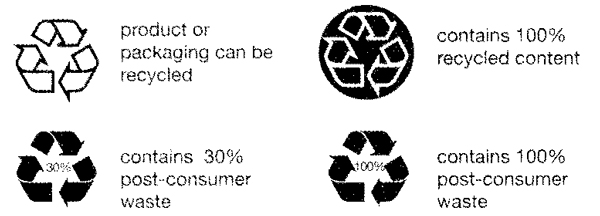
As one top retailer put it a year ago, “There’s a lot of confusion about what ‘recycled’ really means. It’s not always what you think it is.”
Well put.
Retailers are inundated with references to green products now that the term has transcended beyond “trend” to “norm.” And no one clears up the confusion better than Joan Schnee, owner of Green Paper Company and my personal recycling guru.
You know from my previous post that GPC is on top of their game. An up and coming aficionado in recycled papers, Joan decided to take her passion for eco-friendly stationery beyond just selling good product to demystifying the process. Supplying pocket reference guides for GPC retailers’ staff and customers that explain the differences between recyclable, recycled, post-consumer, and virgin, she makes it simple to sort through the hype:
Recyclable After use, the item can be put in a recycling bin by the consumer. The term applies solely to how an item may be disposed of at the end of its life cycle; may or may not contain post-consumer content.
Recycled Made from waste created through the actual manufacturing process. A good example was a line of blue stationery produced by Crane’s several years ago, using leftover pieces of dyed cotton denim from Levi Strauss. Contains zero post-consumer content.
Post-consumer Materials that have been used by the consumer, re-pulped, re-purposed, then reborn in a new form. The only truly green paper; considered the best, most responsible option. Percentage of post-consumer content varies by item.
Virgin paper/wood pulp base Comes directly from trees; is most harmful to the environment since no recycling or re-purposing has occurred. Contains zero post-consumer content.
(As a side note of my own, virgin papers using a 100% cotton pulp base, while not yet re-pulped or re-purposed, are generally considered eco-friendly since cotton is a fully renewable crop, although the use of bleach and other chemicals vary from one producer to the next. They contain zero post-consumer content.)
Obviously, the higher the post-consumer percentage, the better.
Joan doesn’t just talk the talk. Taking her own advice, GPC selects their own suppliers based on strict criteria, including the active commitment each company has made to protecting the ecosystem, their ability to produce goods using hydro-electric power, availability of soy based inks, and capability of streamlining processes to eliminate excess waste and fuel usage.
Make no mistake; the finished product is terrific-—none of that “so 1980” speckled stuff that felt like public restroom paper towels. Eighteen of-the-moment shades, including gleaming white, give retailers a full palette of colors to work with. From the pre-printed packaged goods to bulk blank stock suitable for in-house design work, there’s no shortage of great options to provide the end user.
For more information, check out the Green Paper Company website. Place an order. And be sure to get a stack of those accordian pocket reference guides. They’ll make you look like a superhero in the eyes of your customers.
Reference chart at top courtesy of Green Paper Company, with permission.


Click here to tell me what you think....
What a wonderfully concise reference right here! Thank you for the post – I am off to print it on my post-consumer copy paper! Never thought to look before……….
Hi Cinda:
Thanks so much for bringing clarity to the world of “recycled” paper.
Just a quick note to let you know that those 100 percent cotton fibers in your paper are more environmentally responsible than you might think. Cotton linters and rags are considered recovered fibers because they are the leftovers from the cotton ginning and textile industries. If linters weren’t used to make beautiful papers like Crane’s they would be landfilled or used to supplement feed for cattle. Rags are the waste material from garment manufacturing. They just happen to make the finest paper available.
With best regards,
Peter Hopkins
craneinsider.blogspot.com